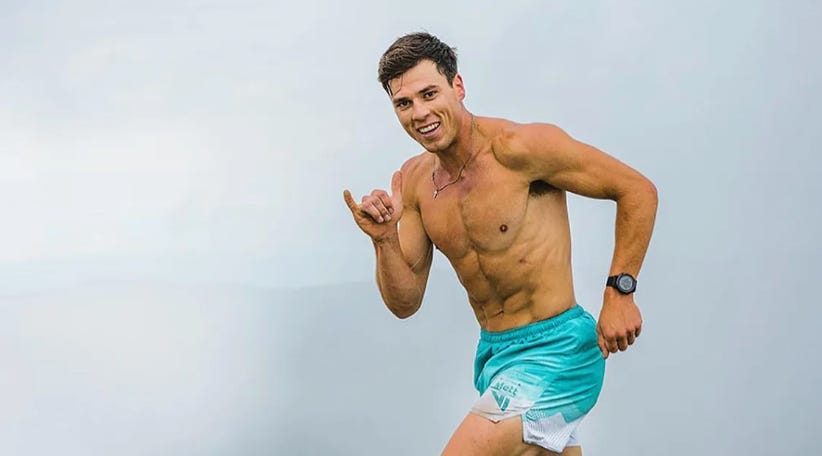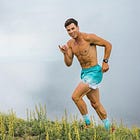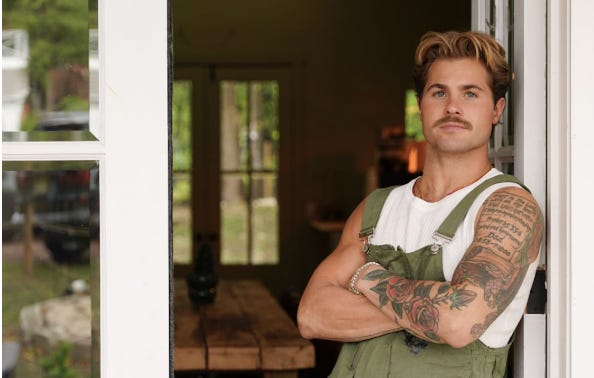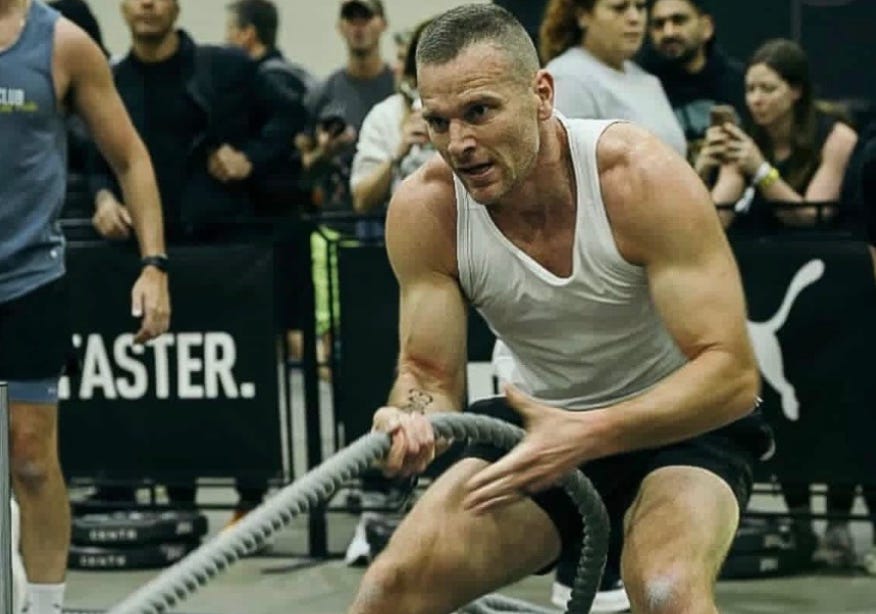Remembering Rylan
Rylan Shadegg, a member of the Hyrox Elite 15 and a champion hybrid racer, died last Sunday. On Instagram, his family said that Rylan died "doing one of the things he loved most, running up mountains as fast as he could and then flying back down them."
Rylan was known both as a fierce competitor and a genuinely kind person. With teammate Ryan Kent, he finished third in Elite Doubles at 2025 Hyrox Worlds in Chicago. Rylan also holds the world record for Deka Fit (28:28), won two Deka Mile world championships (2023, 2024), and took home the 2023 Spartan Trifecta World Championship.
The Hybrid Letter interviewed Rylan in December 2023. In a previously unreleased excerpt, Rylan talked about why his training was different from a lot of other top Hyrox athletes:
One race is not that important to me in my life. Even if I win world champs — I truly believe that I have the capability to win Hyrox Worlds if I just focus on it. But I'm asking myself right now, now that it's an option, is that something that I actually want? Because it's tempting in life to just go after the coolest opportunities, and to forget what actually gives you peace inside and what actually makes you enjoy life.
Sky racing doesn't have a ton of money in it. Sky racing is not super well-known. You run up a super steep technical mountain, and you run down over and over for 15 to 30 miles. And I'm talking 9 thousand feet of vertical gain and loss in a single race, and sometimes even 15 [thousand]. That's super exciting to me. And also really fun for me to train for because I can run up a mountain with my wing and fly off and just do that on repeat. So if it's something that my body allows me to do, that is something I plan on doing.
You can read the full published interview here:
At the edge of endurance, Devon Levesque finds his peace
Devon Levesque has built a reputation on pushing limits. In 2020, he became the first person to bear-crawl an entire New York City Marathon, a feat that was both a grueling display of endurance and a public tribute to mental health awareness and suicide prevention. Since then, he’s co-founded Promix Nutrition and launched Runningman, a three-day festival that blends competition, community, and recovery. Whether navigating Everest, biking across America, or building wellness ventures, Levesque approaches challenge as both a personal test and a way to spark broader conversations about resilience and mental health.
The Hybrid Letter spoke with him about his path into extreme sports, how his advocacy took shape, and why—at the core of everything—he believes progress begins with just showing up.
This interview has been edited for length and clarity
The Hybrid Letter: You grew up surrounded by sports. How did that early environment shape your path into endurance?
Devon Levesque: My dad was a pro weightlifter, and so was my mom, so I’ve been playing sports since I was two. Growing up it was baseball, football, basketball—I was always moving. Running was part of that, and in Idaho and New Hampshire, where I spent most of my childhood, there was a lot of mountain biking too. I was drawn to the outdoors.
Endurance for me wasn’t marathons or races—it was playing football, basketball, and baseball all in the same day, then going fishing, biking, riding horses, helping with the cows, and still having the energy to sit down for dinner. That was my version of endurance: 15–18 hours of activity out in the country.
Honestly, I didn’t even know how long a marathon was until I signed up for one in 2020. I had to look it up and thought, “26.2? Why the point two?” So in the traditional sense, I’m new to endurance sports—five years in—but I feel like I’ve been building that kind of endurance my whole life.
THL: Most people ease into endurance sports. You go straight to the edge—bear crawls, Everest, biking across America. What pulls you toward the extreme?
DL: My “why” has changed. For the bear crawl marathon, it was specific: suicide prevention and raising awareness for men’s mental health. My dad took his life when I was 16, so that’s always been close to me. I wanted to shine a light on the fact that everyone’s going through something, and you don’t have to stay quiet. That was the motivator.
With other challenges—like Everest, where I was out for 47 days—it became about curiosity. We’re only here for a short time. If you’re lucky you live 80 or 90 years. Why not see what’s out there?
There’s also a mental health layer. Long efforts strip everything down. You focus on oxygen, food, keeping your body moving. All the other noise—bills, stress, the bank account—falls away. That presence brings calmness, and for me that’s ultimate strength: controlling your mind and just being.
Even biking across America, riding 100 miles a day with sore legs, you learn to manage only what’s in front of you. That simplicity is where I’ve found my why.
THL: You share these experiences so publicly. What do you want people to take from them?
DL: I hope it encourages people to be more vulnerable. Social media makes it look like everyone has perfect lives, and they don’t. I don’t mind posting about struggles. Life isn’t perfect and that’s okay.
When you really accept that, situations that used to feel overwhelming lose their weight. Vulnerability, especially around mental health, can save lives. At first I thought maybe my posts would help one or two people, but I was nervous to share. The opposite happened—opening up had a far bigger impact than I expected.
That’s the power of being vulnerable. It feels scary, but the ripple effect is huge.
THL: Out of all these challenges, which one pushed you to the absolute breaking point?
DL: The bear crawl marathon and Everest stand out.
For the bear crawl, I started at 5 p.m. in Brooklyn. By 2 a.m., I’d gone 11 miles and crossed the Brooklyn Bridge. It was freezing, I wasn’t even halfway, my headphones had died, and the friends walking with me started to peel off. I hit a wall and broke down. One buddy literally slapped me in the face and said, “Get it together.” That snapped me back. I realized how lucky I was just to be out there and kept moving.
Everest was another level. After summiting, I was coming down and hit a section—a ledge just wide enough for a boot. About 100 people were lined up, waiting to cross. I thought, This is it. I pictured my funeral, what my mom would say, almost made peace with dying.
My partner snapped me out of it. We squeezed past people one by one. It took 45 minutes to clear. Thirty minutes later, the section collapsed. Six to eight people died right where we’d been standing. That hit hard. It could’ve been me.
Those two moments reminded me how quickly things can swing—from breaking down to breaking through, from being alive to being gone.
THL: Runningman feels different from traditional endurance events. Why did you want to create it?
DL: You learn a lot about yourself in gritty challenges. There’s this idea of different kinds of fun. Type One is easy, like grabbing a beer. Type Three almost kills you. Type Two is my favorite—it’s brutal in the moment, like a marathon, but afterward you think, That was amazing. Type Two fun pushes you and teaches you about yourself.
Jesse and I believe in that. He calls it a misogi, a Japanese concept where you take on something with a 50/50 chance of success. Same idea. We’ve done plenty: biking across America, rim-to-rim in the Grand Canyon, 48 miles in 24 hours. Each is about testing yourself and building community.
That’s what we wanted for Runningman. Traditional races are just a day—you pick up your bib, race, have a beer, and go home. Ours is a three-day event where you actually spend time with people, build real relationships, and take on challenges together—cold plunges, long saunas, big runs, HYROX-style workouts. Do gritty stuff alongside others, and the bonds are stronger.
It’s also about community. Jesse and I don’t get to connect with everyone we’d like throughout the year. This event is our way of bringing people together, giving them Type Two fun in an approachable way. No first place, no last place—just you against the clock.
Community has helped me through tough times. Creating an event that combines challenge, fun, and real connection—that’s the point.
THL: Why do these long, grueling events create such tight communities?
DL: Because they’re built on values, not just industries. Maybe you’re into running, or family, or health, or giving back. That’s where the real connections happen.
When Jesse and I share our values, it attracts people who align. So when they show up, it’s not just a bunch of runners—it’s people with the same outlook. That’s why the vibe is strong.
And giving back is part of it. Many people who come are natural givers, and that creates camaraderie. We’ve never had fights or drama. People show up for the right reasons, and when you combine values, you get a community that meshes naturally.
THL: What would you say to someone on the fence about signing up for a challenge?
DL: Half the battle is showing up. I’m not a professional mountaineer. But if you show up to the mountain, take one step, prepare the best you can, you’ll make progress. None of it happens if you don’t first show up.
You’re not going to do that weekend ride if you don’t get yourself to the trailhead. You won’t experience the saunas, the cold plunges, the food trucks, or the runs at our event if you stay home. You have to be there.
Your body is smart. It adapts. It heals. It’s capable of more than people realize. The hardest part is usually just getting there. Once you do, your brain and body rise to the challenge. That’s why I especially encourage non-runners to come out.
THL: After Runningman, what’s next?
DL: A week after, Jesse and a crew are swimming 22 miles across Lake Tahoe. I’ll be paddle boarding alongside them. Then I’m heading to Denali to climb the highest peak in North America.
You can follow Devon on Instagram or check out Runningman.
Athlete of the Week: Chris Beck
Name: Chris Beck
Age: 35
Hometown: Doylestown, PA
Why hybrid? I love competition, and more than anything I love training with a specific focus. Hyrox, Deka, and now Deadly Dozen give me that structure and keep me dialed in on goal times.
Favorite race? Hyrox Chicago, and Deka World Championships last year. I was fortunate enough to make the elite wave for Deka but got humbled by several amazing athletes who performed at such a high level that day. You learn a lot when that happens — it definitely made me hungry to improve and get closer to their level.
Race goals? For Hyrox, I want to improve on my doubles PR of 54:28. For Deka, my goal is to place in the top five in the world in Deka Strong.
Favorite station? The sled push or the tank push—always.
Least favorite station? RAM burpees in Deka. They take your soul when you’re completely exhausted after the bike and the tank. The past couple of years I’ve hit a wall here and lost time.
Something you wish you knew before you started? How awesome and supportive the hybrid community is. The energy and encouragement at events is always incredible.





